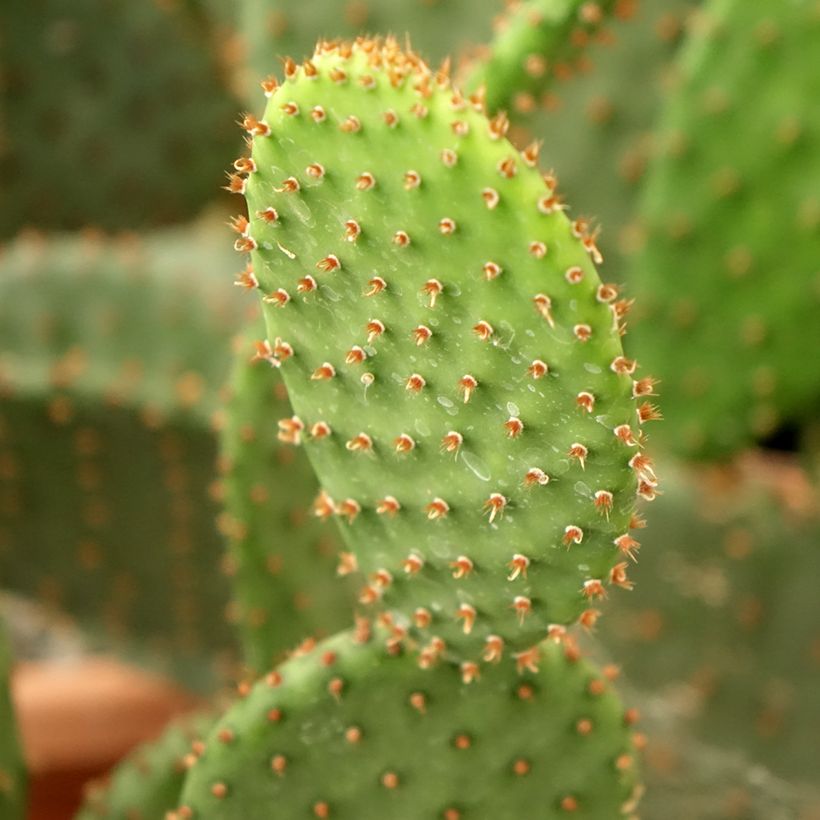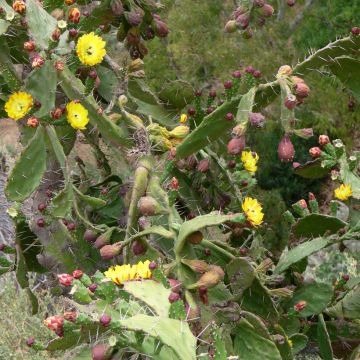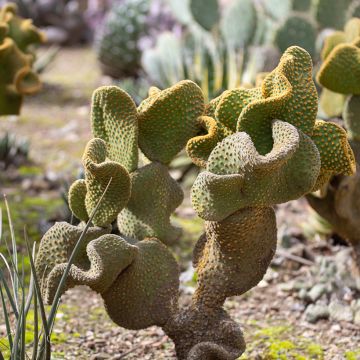

Opuntia lubrica - Prickly Pear


Opuntia lubrica - Prickly Pear


Opuntia lubrica - Prickly Pear
Opuntia lubrica - Prickly Pear
Opuntia lubrica
Red Bunny Ears Cactus, Red Angel's Wings, Brown Bunny Ears Cactus
Special offer!
Receive a €20 voucher for any order over €90 (excluding delivery costs, credit notes, and plastic-free options)!
1- Add your favorite plants to your cart.
2- Once you have reached €90, confirm your order (you can even choose the delivery date!).
3- As soon as your order is shipped, you will receive an email containing your voucher code, valid for 3 months (90 days).
Your voucher is unique and can only be used once, for any order with a minimum value of €20, excluding delivery costs.
Can be combined with other current offers, non-divisible and non-refundable.
Home or relay delivery (depending on size and destination)
Schedule delivery date,
and select date in basket
This plant carries a 12 months recovery warranty
More information
We guarantee the quality of our plants for a full growing cycle, and will replace at our expense any plant that fails to recover under normal climatic and planting conditions.
Would this plant suit my garden?
Set up your Plantfit profile →
Description
The Opuntia lubrica is a variety of prickly pear that is interesting for its cold resistance, but also for the beautiful coloration of its prickly pear pads. The plant, wider than it is tall, is characterized by a succession of modest-sized pads, often devoid of spines but covered in small tufts of yellow glochids that turn rusty, very decorative but irritating. The plant blooms in spring, offering delicate bright yellow flowers. In favorable climates, these flowers give way to pretty small bright red fruits. This Opuntia thrives easily in pots or in the ground, in a very well-drained substrate, without requiring any particular maintenance.
The Opuntia lubrica is a botanical species related to the Prickly Pear (Opuntia ficus-indica). It is a succulent plant in the cactus family. It originates from desert areas in Mexico and Texas, usually on limestone, sandy or rocky soil. Like all prickly pears, it has a very stout trunk that lignifies with age, dividing into flattened fleshy branches called pads. An adult specimen will reach about 80-90 cm (32-35in) in height and 1.20 m (4ft) in width, sometimes more in favorable conditions. With moderate growth, the plant produces 1 or 2 new pads per year from spring to autumn. The shiny surface, glaucous green in color, is adorned with numerous small tufts of tiny prickles that resemble hairs but are very irritating and unpleasant when in contact with the skin. Flowering occurs from May to July, earlier or later depending on the climate and under favorable conditions. Several cup-shaped flowers with a diameter of 4 cm (2in) appear on the edges of the pads, mainly towards their ends. These flowers have fine, slightly translucent petals. They are a bright yellow, usually washed with green in the center, and sometimes fade to a coppery or slightly orange hue. The fruit is bright red, covered in numerous glochids, and contains a juicy, acidic pulp filled with small seeds.
Hardy Opuntias are emblematic cacti of the desolate and arid expanses of Northern America. These succulent plants naturally find their place in dry gardens alongside other more traditional bushes, with which they harmonize well. They can be associated with rock roses, lavender, rosemary, Teucrium, and dry-loving euphorbias. This lubrica species is resistant to frost down to -15°C in dry soil. It can be grown in the ground in a dry rockery or on a dry slope in many regions that are not too humid in winter. They can be grown in pots which allows for sheltering the plants from winter humidity. It is advisable to keep this plant away from pathways and children, due to its formidable tiny spines, transparent and almost invisible to the naked eye, which penetrate our skin with disconcerting ease and are very difficult to remove.
Report an error about the product description
Opuntia lubrica - Prickly Pear in pictures






Flowering
Foliage
Plant habit
Botanical data
Opuntia
lubrica
Cactaceae
Red Bunny Ears Cactus, Red Angel's Wings, Brown Bunny Ears Cactus
North America
Other Opuntia
View all →Planting and care
Plant Opuntia lubrica (rufida) in open ground only in regions that are not too humid or cold in winter. Plant in spring or early autumn choosing an exposure in full sun. The soil will preferably be poor, rocky, stony, sandy, even limestone, but well-drained: This plant appreciates dry, even arid soils in summer, but also in winter. Cultivation in pots is easy, and will be preferred in regions that are too cold and humid, in order to be able to protect the plant from excessive humidity in winter. This species tolerates sea spray and can therefore be grown in coastal regions. It is not known to be susceptible to any pests, except for scale insects (to be particularly monitored in plants grown in greenhouses or conservatories.
Cultivation substrate: 3/4 potting soil + 1/4 topsoil + organic fertilizer for potted plants. Sandy, very stony soil, low in clay for open ground cultivation.
Propagation by cuttings of the "prickly pear" is easy: take a segment at a junction, place it on a cactus soil substrate for a few days until a healing callus forms. Then bury the base of the cutting a little deeper into the soil and water regularly. The plant will not flower or bear fruit before the age of 3 years.
Handle this cactus with gloves and remove them carefully, the fine needles stick to all fabrics.
Planting period
Intended location
Care
This item has not been reviewed yet - be the first to leave a review about it.
Similar products
Haven't found what you were looking for?
Hardiness is the lowest winter temperature a plant can endure without suffering serious damage or even dying. However, hardiness is affected by location (a sheltered area, such as a patio), protection (winter cover) and soil type (hardiness is improved by well-drained soil).

Photo Sharing Terms & Conditions
In order to encourage gardeners to interact and share their experiences, Promesse de fleurs offers various media enabling content to be uploaded onto its Site - in particular via the ‘Photo sharing’ module.
The User agrees to refrain from:
- Posting any content that is illegal, prejudicial, insulting, racist, inciteful to hatred, revisionist, contrary to public decency, that infringes on privacy or on the privacy rights of third parties, in particular the publicity rights of persons and goods, intellectual property rights, or the right to privacy.
- Submitting content on behalf of a third party;
- Impersonate the identity of a third party and/or publish any personal information about a third party;
In general, the User undertakes to refrain from any unethical behaviour.
All Content (in particular text, comments, files, images, photos, videos, creative works, etc.), which may be subject to property or intellectual property rights, image or other private rights, shall remain the property of the User, subject to the limited rights granted by the terms of the licence granted by Promesse de fleurs as stated below. Users are at liberty to publish or not to publish such Content on the Site, notably via the ‘Photo Sharing’ facility, and accept that this Content shall be made public and freely accessible, notably on the Internet.
Users further acknowledge, undertake to have ,and guarantee that they hold all necessary rights and permissions to publish such material on the Site, in particular with regard to the legislation in force pertaining to any privacy, property, intellectual property, image, or contractual rights, or rights of any other nature. By publishing such Content on the Site, Users acknowledge accepting full liability as publishers of the Content within the meaning of the law, and grant Promesse de fleurs, free of charge, an inclusive, worldwide licence for the said Content for the entire duration of its publication, including all reproduction, representation, up/downloading, displaying, performing, transmission, and storage rights.
Users also grant permission for their name to be linked to the Content and accept that this link may not always be made available.
By engaging in posting material, Users consent to their Content becoming automatically accessible on the Internet, in particular on other sites and/or blogs and/or web pages of the Promesse de fleurs site, including in particular social pages and the Promesse de fleurs catalogue.
Users may secure the removal of entrusted content free of charge by issuing a simple request via our contact form.
The flowering period indicated on our website applies to countries and regions located in USDA zone 8 (France, the United Kingdom, Ireland, the Netherlands, etc.)
It will vary according to where you live:
- In zones 9 to 10 (Italy, Spain, Greece, etc.), flowering will occur about 2 to 4 weeks earlier.
- In zones 6 to 7 (Germany, Poland, Slovenia, and lower mountainous regions), flowering will be delayed by 2 to 3 weeks.
- In zone 5 (Central Europe, Scandinavia), blooming will be delayed by 3 to 5 weeks.
In temperate climates, pruning of spring-flowering shrubs (forsythia, spireas, etc.) should be done just after flowering.
Pruning of summer-flowering shrubs (Indian Lilac, Perovskia, etc.) can be done in winter or spring.
In cold regions as well as with frost-sensitive plants, avoid pruning too early when severe frosts may still occur.
The planting period indicated on our website applies to countries and regions located in USDA zone 8 (France, United Kingdom, Ireland, Netherlands).
It will vary according to where you live:
- In Mediterranean zones (Marseille, Madrid, Milan, etc.), autumn and winter are the best planting periods.
- In continental zones (Strasbourg, Munich, Vienna, etc.), delay planting by 2 to 3 weeks in spring and bring it forward by 2 to 4 weeks in autumn.
- In mountainous regions (the Alps, Pyrenees, Carpathians, etc.), it is best to plant in late spring (May-June) or late summer (August-September).
The harvesting period indicated on our website applies to countries and regions in USDA zone 8 (France, England, Ireland, the Netherlands).
In colder areas (Scandinavia, Poland, Austria...) fruit and vegetable harvests are likely to be delayed by 3-4 weeks.
In warmer areas (Italy, Spain, Greece, etc.), harvesting will probably take place earlier, depending on weather conditions.
The sowing periods indicated on our website apply to countries and regions within USDA Zone 8 (France, UK, Ireland, Netherlands).
In colder areas (Scandinavia, Poland, Austria...), delay any outdoor sowing by 3-4 weeks, or sow under glass.
In warmer climes (Italy, Spain, Greece, etc.), bring outdoor sowing forward by a few weeks.



















































